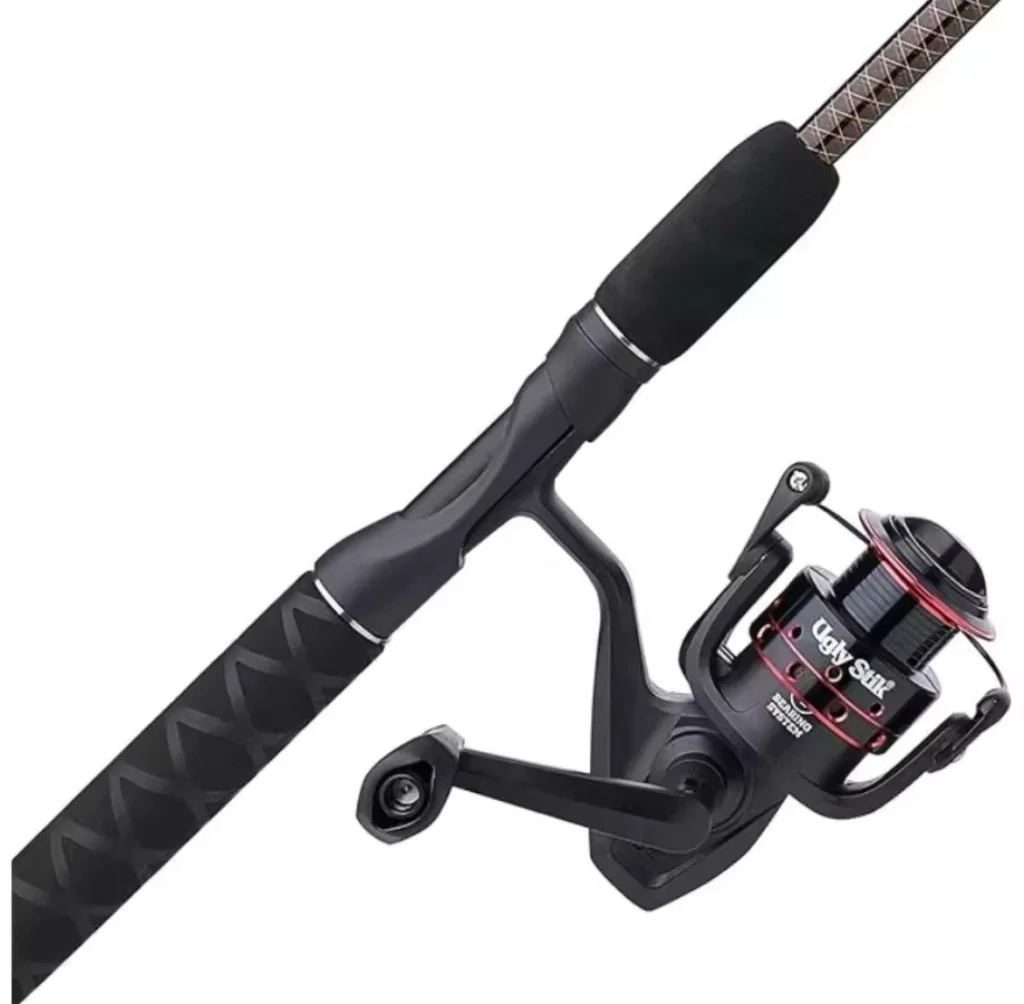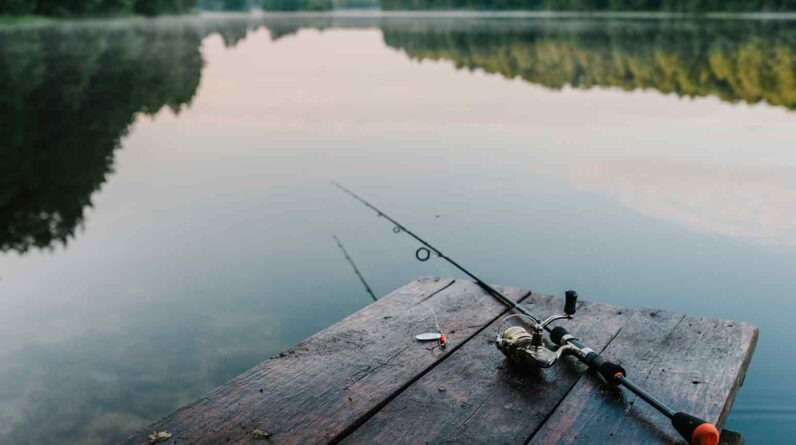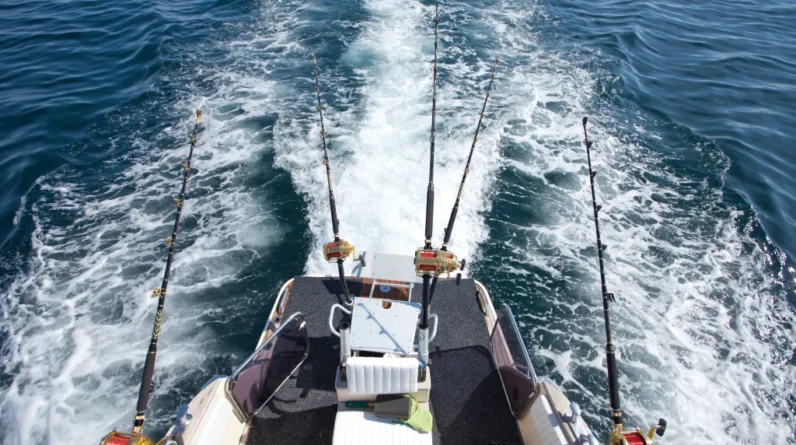Beginner fishing guide: Fishing is one of the oldest and most rewarding outdoor activities, blending relaxation, skill, and adventure. Whether you’re looking to enjoy the quiet peace of sitting by a lake, strengthen family bonds on a weekend outing, or feel the rush of reeling in your very first catch, fishing offers something meaningful for everyone. Still, for beginners, it can seem a little overwhelming—what kind of gear do you actually need? Where are the best places to start fishing? Which simple techniques work best for catching fish without frustration?
Don’t worry at Cheerfulfisherman.com, our team has created several detailed articles to answer those exact questions. This beginner’s guide to fishing brings together all of that knowledge into one easy-to-follow resource. Designed to cut through the confusion, it will walk you step by step through everything you need to know before casting your first line with confidence.

1. Why Start Fishing? Benefits for Beginners
Fishing isn’t just about catching fish—it’s about the entire experience. Here are some reasons why beginners fall in love with fishing:
Stress Relief: Spending time near water has a calming effect on the mind and body. The gentle sounds of rippling water, the rhythm of casting a line, and the quiet moments waiting for a bite all work together to reduce stress levels, lower blood pressure, and improve overall mental health. Fishing offers a perfect escape from the daily hustle, giving you a chance to recharge and reconnect with nature.
Family Bonding: Fishing is an excellent activity for families because it allows people of all ages to participate. From teaching kids how to bait a hook to sharing stories while waiting for a catch, fishing creates quality time that strengthens relationships. It encourages teamwork, patience, and communication, making it more than just a recreational activity—it’s a way to create lasting memories.
Affordable Hobby: Unlike some sports or hobbies that require expensive equipment or memberships, fishing can be very budget-friendly. A basic rod, reel, and tackle are often enough to get started, and many local areas offer free or low-cost access to fishing spots. Over time, you can expand your gear, but even beginners can enjoy the activity without breaking the bank.
Outdoor Exploration: Fishing opens doors to countless outdoor adventures. Whether you’re exploring tranquil lakes, winding rivers, coastal shores, or hidden natural spots, each fishing trip offers a new environment to discover. You’ll encounter wildlife, observe changing seasons, and develop a deeper appreciation for the natural world around you.
Food Source: For those interested in sustainable living, fishing can provide a fresh and healthy source of food. Depending on local regulations, catching your own fish allows you to enjoy meals that are both nutritious and environmentally conscious. It also teaches respect for natural resources and the importance of following sustainable practices while enjoying the outdoors.
Fishing is as much about patience and relaxation as it is about excitement and challenge.

2. Understanding the Basics of Fishing
Before buying gear or planning trips, let’s cover the fundamentals.
Different Types of Fishing
- Freshwater Fishing: Done in lakes, rivers, and ponds. Great for beginners.
- Saltwater Fishing: Done in oceans, bays, and coastal waters. Requires stronger gear.
- Fly Fishing: Uses a lightweight lure (fly). Often done in rivers for trout and salmon.
- Ice Fishing: In colder climates, anglers drill holes in frozen lakes.
- Shore Fishing vs. Boat Fishing: Beginners often start from the shore or a pier.
Common Fishing Terminology
- Casting: Throwing your bait or lure into the water with a fishing rod.
- Bait: Natural or artificial food used to attract fish.
- Hook: The sharp piece that catches the fish.
- Drag: Tension setting on your reel that controls how much resistance the fish feels.
- Catch and Release: Safely returning a fish to the water after catching it.
3. Fishing Gear for Beginners
One of the most common beginner questions is: What fishing gear do I need? Let’s break it down.
Rods and Reels
Selecting the right rod and reel is one of the most important steps for any angler, whether you’re just starting out or have years of experience. The type of rod and reel you choose can make a huge difference in your casting, accuracy, and overall enjoyment on the water. Here’s a closer look at the most common options:
- 1. Spinning Rod and Reel – Perfect for Beginners Spinning rods and reels are widely considered the best choice for beginners. They are incredibly versatile and easy to use, making them suitable for a wide range of fishing conditions—from calm lakes and rivers to inshore saltwater spots. With a spinning setup, casting light lures and baits becomes effortless, allowing you to focus on learning essential techniques like reeling, hook setting, and fish handling. Additionally, spinning reels are low-maintenance and forgiving, reducing the frustration often experienced by new anglers.
- 2. Baitcasting Reel – Advanced Precision for Experienced Anglers Baitcasting reels are designed for more advanced anglers who want precision and power. These reels are ideal for long-distance casting and handling heavier lures or larger fish species, such as bass, pike, or muskie. While baitcasting offers superior accuracy and control, it comes with a learning curve. Proper technique is essential to prevent backlash or line tangles, but once mastered, a baitcasting setup gives you unmatched casting ability and strength for challenging fishing conditions.
- 3. Fly Rod – Specialized Gear for Fly Fishing Enthusiasts Fly rods are a unique type of fishing equipment used specifically for fly fishing. Unlike conventional rods, fly rods are designed to cast lightweight artificial flies rather than heavy baits. Fly fishing emphasizes technique, presentation, and a connection with the water, requiring skillful casting to place flies accurately on the surface or beneath the water. Typically used for species like trout and salmon, fly rods offer a more artistic and immersive fishing experience. Saltwater fly fishing is also growing in popularity, allowing anglers to target larger species with specialized flies.
- Choosing the Right Rod for Your Goals When selecting your first rod and reel, consider your fishing location, target species, and personal preference. Beginners often find spinning rods the easiest to start with, while more experienced anglers may gravitate toward baitcasting or fly rods to match their fishing style. Investing in the right equipment not only improves your success on the water but also makes every fishing trip more enjoyable.
For beginners: a medium light spinning combo (rod + reel) is affordable and easy to handle.
Fishing Line
- Monofilament Line: Affordable, flexible, and beginner-friendly.
- Braided Line: Stronger but harder to manage for beginners.
- Fluorocarbon Line: Nearly invisible in water but more expensive.
Hooks, Weights, and Floats
- Hooks: When you’re just starting out, choosing the right hook can make all the difference. Smaller hooks, usually in the size 6–10 range, are ideal for beginners because they work well with a variety of smaller baits such as worms, corn, or dough balls. These hooks are easier to handle, less intimidating, and increase your chances of catching fish like bluegill, perch, or small bass. Remember, a smaller hook can still catch a big fish, but a hook that’s too large may scare away smaller, more common fish.
- Weights/Sinkers: Weights, also called sinkers, are small pieces of lead, steel, or other materials designed to help your bait sink to the right depth. Without them, your bait might just float on the surface, making it harder to reach fish swimming below. For beginners, a few simple split-shot sinkers are perfect—they’re easy to pinch onto your line and just as easy to remove. The key is balance: you want enough weight to keep your bait where the fish are but not so much that it feels unnatural when they bite.
- Floats/Bobbers: Floats, also known as bobbers, serve two important purposes. First, they keep your bait suspended in the water at a set depth so it doesn’t sink to the bottom where fish may not be feeding. Second, they act as a visual indicator—when a fish nibbles, your bobber moves, bobs, or even disappears under the water, signaling it’s time to reel in. For beginners, round red-and-white plastic bobbers are a classic choice because they’re inexpensive and easy to clip onto your line. As you gain experience, you might experiment with slimmer pencil-style floats, which are more sensitive and show even the lightest bites.
Bait and Lures
- Live Bait: Using live bait such as worms, minnows, or crickets is one of the easiest and most effective ways for beginners to catch fish. Live bait naturally attracts fish because it moves and smells like their natural prey, making it highly appealing. Worms are ideal for freshwater fishing and can catch a wide variety of species, from bass to panfish. Minnows are perfect for targeting larger predatory fish, while crickets are particularly effective for panfish and trout. Live bait often increases your chances of a successful catch, especially if you’re just starting out and learning how fish behave.
- Artificial Lures: Artificial lures, including plastic worms, crankbaits, and spinners, offer more versatility and can be used to target specific species in different water conditions. Plastic worms mimic the movement of real worms and are great for bass fishing. Crankbaits imitate injured baitfish, triggering predatory instincts, while spinners create vibrations and flashes that attract fish from a distance. Unlike live bait, artificial lures require some practice to master the right casting techniques, retrieval speeds, and lure selection based on water type and fish species. However, once learned, lures give anglers the advantage of reusability and the ability to cover more water efficiently.
Essential Accessories
- Tackle box
- Pliers (to remove hooks)
- Net (to land fish safely)
- Fishing license (mandatory in most areas)
- Polarized sunglasses (to reduce water glare)

4. Choosing the Right Fishing Location
Where you fish matters just as much as your gear.
Freshwater vs. Saltwater Fishing
- Freshwater Fishing: Easier, more accessible, common species like bass, bluegill, and trout.
- Saltwater Fishing: Bigger fish, more challenging conditions, species like snapper, mackerel, and redfish.
Popular Beginner Spots
- Ponds and small lakes (calm water, easy to access)
- Fishing piers (saltwater beginners)
- Community fishing areas stocked with fish
5. Licenses and Regulations
Before fishing, check your local laws:
- Most regions require a fishing license.
- Follow size and bag limits (how many fish you can keep).
- Respect seasonal restrictions for certain fish.

6. Basic Fishing Techniques for Beginners
Casting Techniques
- Overhead Cast: The overhead cast is the most common casting technique and the easiest for beginners to learn. It involves bringing the rod straight back over your shoulder and then smoothly swinging it forward to launch the lure or bait. This method provides good distance and accuracy, making it ideal for open areas such as lakes, ponds, and wide rivers. It’s also a great way to build confidence in handling the rod before trying more advanced casts.
- Sidearm Cast: The sidearm cast is particularly useful when fishing in areas with obstacles like overhanging trees, bridges, or docks where a vertical cast could snag. Instead of casting over your head, the rod is swung sideways, keeping the line closer to the water’s surface. This method helps keep your lure low and allows you to place it under cover where fish often hide. It’s especially helpful when fishing in streams, rivers with thick vegetation, or shaded areas where fish seek shelter.
- Flip and Pitch: Flipping and pitching are short-distance casting techniques that focus on precision rather than distance. Anglers use these methods when targeting fish near structures such as docks, brush piles, lily pads, or submerged logs. With a flip or pitch, the lure enters the water quietly, reducing the chance of spooking fish. These casts are favored by bass anglers who need to present their bait naturally and accurately in tight spots. While they require a bit more practice to master, they can greatly increase your success in catching fish hiding close to cover.
Setting the Hook
When a fish bites, quickly but firmly pull the rod back to secure the hook in the fish’s mouth.
Reeling in Your Catch
- Keep your rod tip up.
- Let the drag work—don’t force the reel.
- Reel steadily until the fish is close enough to land.
7. Beginner-Friendly Fish Species to Target
For those new to fishing, choosing the right species is crucial to building confidence and enjoying the experience. Some fish are easier to catch, more abundant, and less intimidating, making them ideal for beginners. Here are some beginner-friendly fish species to consider:
1. Bluegill and Sunfish
Bluegill and other sunfish species are some of the easiest freshwater fish to catch. They are abundant in lakes, ponds, and slow-moving rivers, and they readily bite on worms, crickets, or small artificial baits. Their small size makes them less intimidating, and catching them often provides instant gratification for beginners.
2. Largemouth Bass
Largemouth bass are one of the most popular freshwater sport fish. While they can put up a fight, they are generally accessible in most freshwater lakes and ponds. Beginners can target them using live bait such as minnows or simple lures like plastic worms or crankbaits. Learning to catch bass also helps anglers practice casting and retrieval techniques.
3. Trout
Trout, including rainbow and brook trout, are often stocked in rivers and lakes, providing reliable opportunities for new anglers. They respond well to live bait like worms or salmon eggs and are also suitable for fly fishing beginners using basic flies. Trout fishing teaches patience and reading water currents, valuable skills for more advanced fishing later.
4. Catfish
Catfish are a beginner-friendly option because they are bottom feeders and relatively easy to catch with simple bait such as cut fish, chicken liver, or commercial stink baits. They are hardy fish, providing the thrill of a fight without requiring complex techniques. Nighttime catfishing can also add excitement for those looking for a unique experience.
5. Crappie
Crappie are smaller freshwater fish that are abundant in many lakes and reservoirs. They tend to school, meaning that once you find one, there’s a good chance of catching several. Using light tackle and small jigs or live minnows makes crappie fishing both fun and rewarding for beginners.
6. Perch
Yellow perch are often overlooked but are excellent for beginner anglers. They are easy to catch in freshwater lakes and rivers and bite on worms, small minnows, or jigs. Perch are also known for their tasty fillets, making them a satisfying catch both for sport and for the table.
7. Panfish in General
Many species categorized as “panfish,” including sunfish, crappie, and perch, are ideal for beginners due to their abundance, small size, and willingness to bite. These fish offer excellent practice for casting, handling, and learning to detect bites without becoming discouraged.

8. Safety Tips for New Anglers
- Always wear a life jacket near deep or moving water.
- Handle hooks carefully—they’re sharp.
- Protect your skin with sunscreen and bug spray.
- Stay hydrated during long fishing trips.
9. Fishing Etiquette Every Beginner Should Know
- Give other anglers space.
- Don’t leave trash behind.
- Respect private property.
- Handle fish gently if practicing catch and release.
10. Tips to Improve Your Fishing Skills Over Time
- Learn to read water: Look for structures like rocks, logs, or weed beds where fish hide.
- Fish early morning or late evening—prime feeding times.
- Try different baits and techniques until you find what works.
- Join local fishing clubs or online communities for advice.

11. Common Mistakes Beginners Make (and How to Avoid Them)
Fishing is a relaxing and rewarding hobby, but for beginners, it can also be frustrating if common mistakes get in the way of success. Understanding and avoiding these pitfalls can make your early fishing experiences more enjoyable and productive. Here are some of the most common mistakes beginners make—and practical tips on how to avoid them:
1. Using the Wrong Gear
One of the first challenges beginners face is selecting the correct fishing equipment. Using a rod, reel, or line that doesn’t match your target fish or fishing environment can make casting difficult, reduce your chances of catching fish, and even damage your gear.
How to Avoid It:
- Research the type of fish in your area and the best gear for catching them.
- Start with versatile beginner-friendly rods and reels designed for multiple fish species.
- Ask local bait shops or experienced anglers for advice on equipment.
2. Poor Knot Tying
Even the best bait and tackle won’t help if your knots aren’t secure. Weak or improperly tied knots often lead to losing fish.
How to Avoid It:
- Learn a few essential knots, such as the improved clinch knot or Palomar knot.
- Practice tying knots at home until you can do it quickly and securely.
- Always check your knots before casting.
3. Neglecting the Importance of Bait and Lures
Using the wrong bait or lure for the fish species can make your fishing trip unproductive. Many beginners stick with one type of bait without considering what fish are feeding on.
How to Avoid It:
- Observe local conditions and fish preferences.
- Experiment with live bait, artificial lures, and combinations.
- Learn which colors, sizes, and movements attract specific fish.
4. Ignoring Weather and Water Conditions
Fish behavior is heavily influenced by weather, water temperature, and tides. Ignoring these factors can leave beginners frustrated when fish simply won’t bite.
How to Avoid It:
- Check the weather forecast and water conditions before heading out.
- Learn the best times of day and seasons for different fish species.
- Adjust your fishing techniques based on conditions.
5. Improper Casting Techniques
Casting may seem simple, but beginners often struggle with distance and accuracy. Poor casting can spook fish or place bait in ineffective spots.
How to Avoid It:
- Practice your casting in an open area before going fishing.
- Learn techniques like sidearm, overhead, and roll casting.
- Start with short casts and gradually increase distance as your confidence grows.
6. Lack of Patience
Fishing requires patience. Beginners often give up too soon or keep moving without giving fish a chance to bite.
How to Avoid It:
- Set realistic expectations for your first few trips.
- Focus on enjoying the experience rather than just catching fish.
- Give each fishing spot time before moving on.
7. Not Learning Local Regulations
Ignoring fishing regulations, such as size limits, bag limits, and protected species, can lead to fines or harming fish populations.
How to Avoid It:
- Research local fishing rules and licensing requirements.
- Keep a reference of regulations in your tackle box or smartphone.
- Follow catch-and-release practices when necessary.
8. Overlooking Fish Handling and Safety
Even if you catch a fish, improper handling can injure it or even you. Beginners often remove hooks incorrectly or handle fish roughly.
How to Avoid It:
- Learn safe techniques for removing hooks and releasing fish.
- Use wet hands or gloves to handle fish to protect their slime coat.
- Keep first aid supplies handy for minor injuries.

12. Budget-Friendly Beginner Fishing Setup
Starting fishing doesn’t have to drain your wallet. With a few carefully chosen pieces of gear, you can enjoy this relaxing and rewarding hobby without overspending. A budget-friendly beginner fishing setup focuses on simplicity, versatility, and affordability, allowing you to learn the basics before committing to high-end equipment.
1. Rod and Reel Combo
For beginners, a pre-packaged rod and reel combo is the most cost-effective way to get started. These combos are designed for ease of use, usually pairing a spinning reel with a medium-action rod that works for various freshwater species like bass, trout, and panfish. Brands such as Ugly Stik, Shimano, and Pflueger offer durable and reliable options for under $50.
2. Fishing Line
Monofilament line is ideal for beginners due to its flexibility, strength, and low cost. A 6-12 lb test line works well for most freshwater fishing situations. Monofilament is forgiving when casting, reducing the likelihood of tangled lines, making it perfect for beginners learning the ropes.
3. Hooks, Sinkers, and Bobbers
A basic tackle box should include a variety of hooks (sizes 6–10 are versatile), a few split-shot sinkers, and standard bobbers. These inexpensive items allow you to experiment with different setups and techniques without spending much.
4. Bait Options
Live bait, such as worms or minnows, is highly effective and inexpensive for beginners. Artificial baits like soft plastics, small crankbaits, or spinnerbaits are another great choice and can be reused multiple times, offering long-term value.
5. Essential Accessories
A few small accessories can improve your experience without breaking the bank:
- Needle-nose pliers for hook removal
- Tackle box to keep your gear organized
- Fishing license (required in most areas)
- Small landing net for safely handling fish
6. Optional Extras
If your budget allows, consider a lightweight fishing chair, polarized sunglasses to reduce water glare, and a simple cooler for storing your catch. These items make your fishing trips more comfortable and enjoyable.

By starting with a budget-friendly beginner fishing setup, you can gain experience, figure out what types of fishing you enjoy, and gradually upgrade your gear as your skills improve. This approach ensures that fishing remains fun, accessible, and financially manageable for newcomers.
13. Preparing for Your First Fishing Trip
Checklist before you go:
- Fishing rod and reel
- Bait and tackle
- Fishing license
- Comfortable clothing and hat
- Snacks, drinks, sunscreen, bug spray
- Patience and a good attitude

14. Final Thoughts: Why Fishing is Worth Trying
Fishing is more than catching fish—it’s about slowing down, enjoying nature, and learning patience. With the right gear, basic knowledge, and practice, anyone can become a successful angler. Whether you dream of fishing quiet lakes, rushing rivers, or the open sea, this beginner’s guide to fishing gives you everything you need to start your journey.
So grab a rod, head to the water, and cast your first line—you might just discover a lifelong passion.






